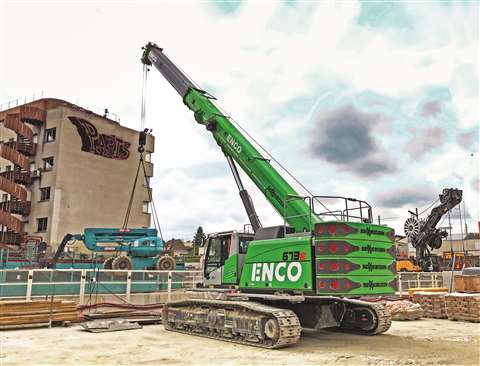Telescopic crawler cranes: top telecrawlers
13 May 2019
Geographically, telescopic crawlers (crawler-tracked extendable-boom cranes) are perhaps most closely associated with the Far East and the USA, where their use has been most widespread. Benefits of shorter set up times, ease of transport, and variability of the boom system, however, means their popularity is growing fast in other global regions.
“We’re seeing the popularity of this type of crane grow in Latin America,” confirms John Blair, product manager for USA-headquartered crane manufacturer Manitowoc. Specifically, he’s referring to the GHC30, a 30 tonne capacity telecrawler launched in 2017. It is the smallest in Manitowoc’s GHC telecrawler range. The rest of the range comprises the GHC50, GHC55, GHC75 and GHC130; the range was developed in conjunction with crane manufacturer Sennebogen Maschinenfabrik, which is headquartered in Germany.
“We talked to a number of dealers and customers about the telescoping crawler line and about how we could expand the range,” Blair continues. “Customers that are engaged in utility, energy, construction and barge-mounted work, for example, indicated that a crane with a smaller footprint would help them increase manoeuvrability and efficiency on many job sites.”
Europe is another market with a developing taste for telecrawlers, as underscored by Japanese crane manufacturer Tadano’s decision to now make two of its GTC series telecrawlers, the GTC-600 and GTC-800, available there.
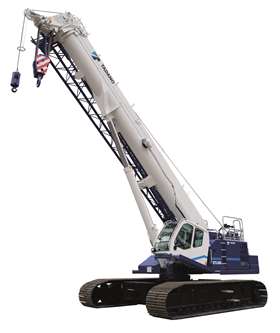
Developed in conjunction with USA-based telecrawler manufacturer Tadano Mantis, Tadano says the 60-tonne capacity GTC-600 and the 80-tonne capacity GTC-800 are suitable for a wide range of applications, particularly in the growing power transmission, bridge and civil, and foundation construction markets. The company also hopes the models will expand the broader appeal of the crane toward lift crane-based markets.
The GTC-800 has a full power, five-section 11.5 to 43.0 m hydraulic boom, while the GTC-600 has a four-section 11.5 to 36.0 m full power hydraulic boom. Tadano’s telecrawlers have half-round booms, manufactured by Tadano Japan. The main boom is complimented with a 10.1 / 17.7 m bi-fold jib that offsets at 3.5 degrees, 25 degrees, and 45 degrees. The maximum lifting height with the jib erected is 60.4 m. An optional 2.5 m heavy lift jib with a capacity of 21.4 tonnes that offsets at 3.5 degrees and 30 degrees is also available. Both cranes have an optional boom mounted auger system that can be mounted to the boom base section or to the second stage of the boom for variable radius drilling.
Both cranes are powered by a Cummins Euromot Stage IV, QSB6.7 diesel engine rated 231 kW @ 2,200 rpm. Engine throttle control is by either auto-idle control, adaptive throttle control, or by foot pedal control. The swing system is controlled by a separate closed loop hydrostatic transmission and the maximum swing speed is 2.0 rpm. The travel system features two-speed track drives. For the GTC-800 this means its maximum speed is 3.4 km/h and it has a maximum unladen gradability of 78 %. And for the GTC-600, its maximum speed is 3.8 km/h and it has a maximum unladen gradability of 78 %. The standard track shoe for the GTC-800 is an 800 mm wide three-bar semi-grouser. An optional 800 mm wide steel flat shoe is also available. The standard track shoe for the GTC-600 is a 900 mm wide three-bar semi-grouser. Optional 800 mm wide shoes can also be specified.
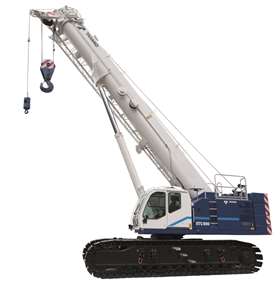
Both cranes have Tadano’s Opti-Width track positioning system as standard. Tadano has used the system on its rough terrain cranes for a number of years now. It claims Opti-Width allows both symmetrical and asymmetrical track positions during reduced track width operation with the aim of providing optimum lifting performance at all track widths. The track width is monitored and the data analysed by the crane’s AML-C Rated Capacity Indicator. The optimal track width operating load chart is selected by the AML-C based on each side track position, explains Tadano. This, it says, optimises the capacity of the crane through 360 degrees. Tadano says zoned load charts are provided based on asymmetrical track position setup and a slewing soft-stop safety function is used when capacity is limited at the edge of an operating zone.
Adjustable spread
Tadano Mantis says that by using the system, asymmetric track position setups can improve lifting capacities by as much as 50 % over symmetrical, reduced track width configurations. It says that this makes it good for operation on congested job sites where the crane is operated with less than full track width. Tadano adds that the crane undercarriage has sufficient hydraulic power to extend and retract the tracks on demand and, once set to the operating width, the tracks do not require pinning in position.
The GTC series cranes also have automatic switching out-of-level load charts. Tadano says this means the crane slope sensor provides continual slope measurement, and the AML-C system automatically sets the load chart based on the slope of the ground up to 1.5 degrees, 2.5 degrees, or four degrees. The GTC Series cranes feature a base lifting chart that allows up to 1.5 degrees slope allowance.
It looks like, depending on how the GTC-600 and GTC-800 fare, Tadano could be considering introducing further GTC models into Europe as the 35 tonne capacity GTC-350 and the 50 tonne capacity GTC-500 are due to be issued CE cerification – which means they could be sold in Europe.
The GTC-500 is the latest in the Tadano range of telecrawlers and was launched in autumn 2018. Designed and built in the USA, it lifts 50 tonnes at 2.5 metres radius (50 US ton at 10 feet radius) and its four-section full-power main boom is 34.7 m fully extended. Maximum lifting height with full main boom and fly jib is 51.9 m.
It is designed to be a one-truck crane and comes in at less than 103,000 lb (46.72 tonnes) which in the USA is the maximum weight for a standard truck load. At that weight crawler side frames and tracks stay on, as does the counterweight, jib and two winches.
Versions with standard and extra counterweight packages are available at 17,400 pounds (7,893 kg) and 28,200 pounds (12,791 kg). A bi-fold jib is standard as is a tilting cab to 20 degrees. Like the other models in the series it is designed to operate out of level. The lifting chart at the maximum of 4 degrees out of level is more than 70 percent of the chart for level ground and keeps the 50 tonne rating.
The GTC-500 also has the Opti-Width function. Power is from a 6.7 litre 260 hp (194 kW) straight six-cylinder Cummins QSB6.7 turbo diesel engine. Options include an auger, work platform and a cold weather package to -40 degrees centigrade.
Although Tadano is hoping the European market will take to its GTC-600 and GTC-800 telecrawlers, it is not neglecting markets closer to home where interest in telecrawlers is still growing. This interest is demonstrated by Singapore-based heavy lifting contractor Sin Leng Industries, which has added a Tadano GTC-800 telescopic boom crawler crane to its equipment fleet.
Sin Leng Industries has a fleet of more than 30 cranes, including rough terrains, truck cranes, and both telescopic and lattice boom crawler cranes. However, this is its first Tadano crawler crane and its first 80 tonner in this crane type.
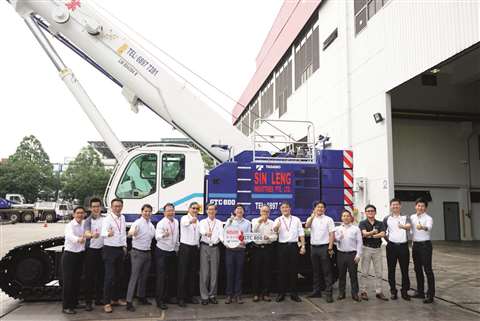
“The GTC-800 is a new model and we are interested to see how the crane will fit into the Singapore market and its application in the Singapore construction landscape,” says Ang Dun Hao – operations manager at Sin Leng Industries. “There is a trend shifting towards crawler telescopic cranes, due to site constraints. Having mobile and rough terrain cranes with outriggers makes work inefficient as most sites require the cranes to shift along the access [route] in between lifts.
“Also, it does not require an assist crane to erect and the ease of mobilisation makes it a much more attractive to use in a job site.
“What I like about the GTC-800 is the simplicity of operating the crane. The LMI system is easy to operate. For example, the operator does not have to individually select the boom sections to extend or retract. It is all determined by the computer.”
Growing market
And in the telecrawler heartland of the USA, the popularity of the crane type also continues. “It’s a growing market,” states David Worsham, general manager at Texas, USA-based crane sales and rental company Holt Crane & Equipment. The company is a dealer for USA-based crane manufacturer Link-Belt and has five Link-Belt telecrawlers in its fleet.
Holt reports the highest demand is for “middle of the road” capacity telecrawlers, in the 75 to 140 ton range. “Out of every five or six calls for rental equipment, one of them is for a telescopic crawler,” Worsham continues. “It’s a great machine in certain applications. The transportability is nice but the big plus is that it’s got the best of both worlds – you’ve got the crawler and the telescopic boom.
“With your traditional crawler you have a fixed amount of boom and that’s what you’re stuck with. Let’s say you need to make a lift 100 yards away, but there’s an obstruction in the way. With a traditional crawler, you have to knock the boom out, move the crane, then build the boom back. That could take half a day. But with a telescopic crawler you can suck the boom in, crawl to the location you need to be and go back to work 10 minutes later. The time saving is incredible.”
This versatility and time saving potential offered by telecrawlers were also points expressed by Ron McCoy, crane superintendent for The Kelly Group of Decatur, Illinois, USA. The company runs five metal fabrication facilities and serves the agribusiness community and other industries including chemical plants, paper mills, and manufacturing facilities in several US states.
The Kelly Group rented a new Link-Belt 250 ton (230 tonne) TCC-2500 telescopic crawler crane from The All Family of Companies. In a little over seven months, the TCC-2500 logged 1,650 working hours, travelling a distance of ten miles working around a railroad discharge facility in an agro-refinery complex. The rail line was flanked by silos and tanks with rooftop walkways, conveyors, and enclosed motors.
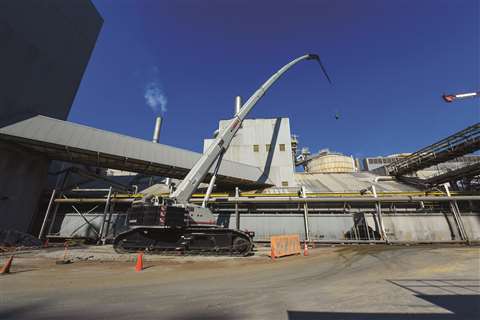
“When the trains came in or went through, we retracted the boom, walked it over the train tracks to the other side, let the train cars come by, and then went back to the work location,” McCoy says. “We walked it in, set it up, had the boom out, did the picks, pulled the boom back in, and walked it out several times a day. Anything else was not really feasible. A big crawler crane did not have the space to be erected and lay it down when needed. With a truck crane, it would have had to be a much larger capacity rig, over 500 tonne capacity.
“We could have retracted the boom and lifted up the outriggers, but then we’d have lost time by taking all the counterweights off (to reduce ground pressure) before moving it across the tracks. This would be at least twice a day. So the TCC-2500 was extremely helpful. We figured out that we saved over $800,000 during this project just because of that crane, and that is a conservative estimate.” With potential savings like that on offer, backed by glowing endorsements from end users such as Worsham and Dun Hao, the telecrawler market looks set to be upgraded from being the starter to becoming the main course.”
Enco uses Sennebogen telecrawler in Paris rail project
French crane rental company Enco was one of the first to buy an updated version of Sennebogen’s 673E telescopic boom crawler crane. “There is a growing demand for telescopic crawler cranes in the French market,” comments Thierry Bouvelot, manager at Enco, “but only a few machines exist.”
Visually, the crane has been updated using lighter plastic cladding. It also has more space between the upper and lower to allow better access for maintenance, achieved by raising the undercarriage 75 mm. The crane has a central lubrication system for all pivot points and for the slewing ring, which reduces the amount of servicing, says Sennebogen.
The railing on the upper carriage can now be folded inward for easier transport. Another new feature is the flange-mounted double collapsible jib: the fly boom is bolted to the main boom and can be folded in two stages, enabling hook heights up to 50 m to be achieved quickly and easily, says Sennebogen. Power is from a Cummins Stage V diesel and there is a larger cab. In the cab, the driver’s seat and controls have also been revised, being mounted directly onto the seat and moving with it. The cab’s sliding door has been enlarged to aid entry and exit.
After Intermat, Enco took delivery and put it straight to work on the Grand Paris Express project. This large-scale development of public transport is one of Europe’s largest infrastructure projects. It comprises 68 stations and a network of automated underground lines. It is expected to be completed by 2030. The 673E is being used for logistics and heavy lifting duties during the construction of an underground station at a connection point between ‘Line 15 South’ on the Grand Paris Express ring and an existing ‘RER’ suburban railroad. A key task is to position steel cages for diaphragm wall work. It uses a specially developed diaphragm wall grab and compact hydro rotary cutter.
The excavation work is being carried out by Cap Excavation, managed by Vinci Construction, along with foundation work from Botte Fondations and Spie Batignolles Fondations. Work on the job site is complicated by the fact that it sometimes needs to take place underneath existing tracks. According to Sennebogen, this is where its compact size and telescoping boom come into their own. However, to ensure the greatest possible safety, the crane has also been fitted with a special control system developed by Spie Batignolles Fondations and Sennebogen’s French sales and service partner Sygmat.
